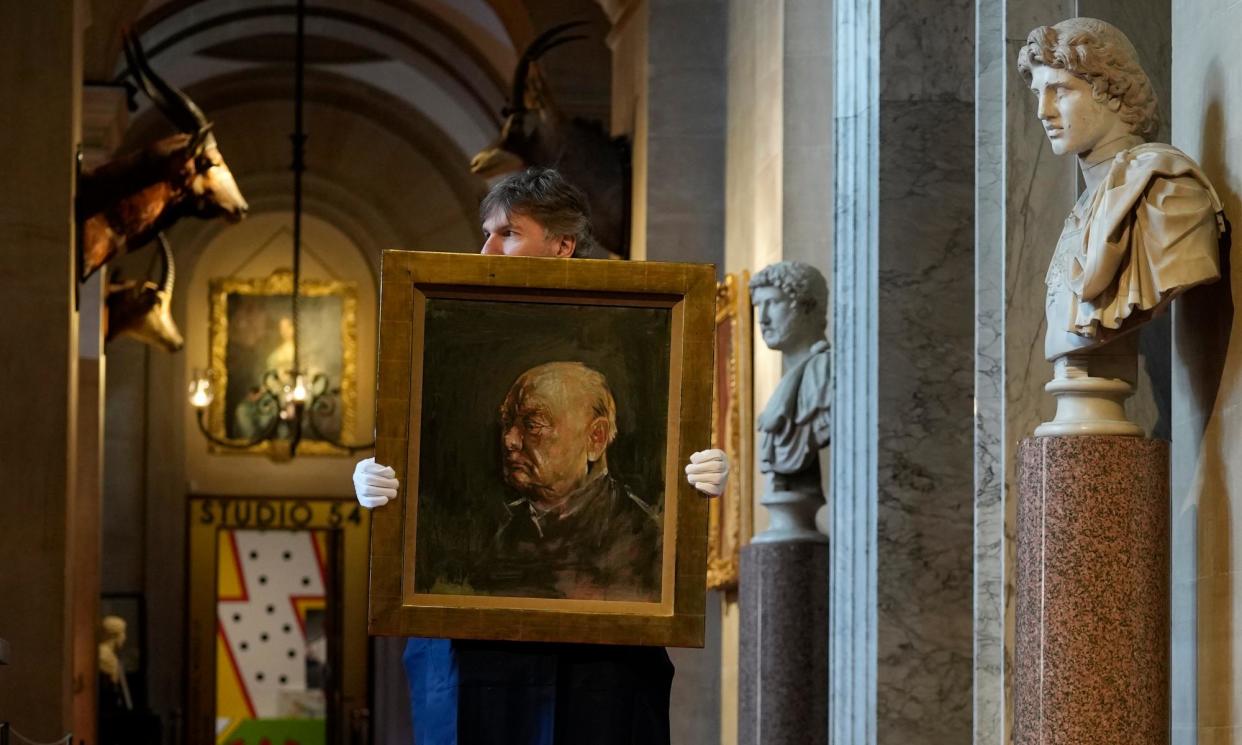Study for portrait Winston Churchill disliked goes on show at his old home

An intimate study of Winston Churchill that has been in private hands for seven decades has gone on show in the room at Blenheim Palace in which Britain’s most famous prime minister was born, before being auctioned in June.
It was the work of Graham Sutherland, one of the most highly regarded artists of his time. Sutherland was commissioned to paint Churchill by the Houses of Parliament to mark the wartime leader’s 80th birthday in November 1954.
The final portrait was famously not to Churchill’s liking, who declared it a “remarkable example of modern art”, prompting dismissive laughter from Tory grandees. Instead of being hung in parliament, it was taken to Chartwell, Churchill’s home in Kent, and was later destroyed in a bonfire.
An episode of hit Netflix drama the Crown revolved around the creation of the painting and showed Churchill’s wife Clementine watching it go up in flames following its unveiling.
During several months that Sutherland spent at Chartwell working on the commission, he produced preliminary sketches and oil studies in preparation for the final work. Among them was a study of Churchill painted at an angle and looking pensive.
Sutherland kept this work, and later gave it to Alfred Hecht, who was an art dealer, collector and framer of many paintings by the great artists of the day. It remained in Hecht’s ownership for the rest of his life, and was bequeathed to the present owner who is now selling it.
“It’s not a formal portrait, but an intimate portrayal,” said André Zlattinger, the head of modern British and Irish art at Sotheby’s, which is auctioning the work. “Churchill is caught in a moment of absent-minded thoughtfulness.” The work was last on public show in 1982.
Churchill and Sutherland had not met before the commission of the birthday portrait, although by then Sutherland was at the forefront of modern British art and was regarded as more important than his contemporary Francis Bacon. Churchill was himself a keen and well-regarded amateur artist.
At their first meeting, Churchill asked Sutherland: “How are you going to paint me? As a cherub or as the bulldog?” Churchill was nicknamed the bulldog for his physical appearance and his temperament. Sutherland replied by saying it depended what image Churchill presented, later remarking that the prime minister had consistently shown himself as a bulldog.
The two men became friends, although Sutherland repeatedly resisted Churchill’s requests to view his work-in-progress. On seeing the finished portrait, Churchill described it to his personal doctor as “filthy and malignant”. He believed it was part of a conspiracy to bring him down, and threatened not to attend the unveiling ceremony.
The historian Simon Schama said in 2015: “The painting is an extraordinary homage to Churchill. What Sutherland saw in front of him was a magnificent ruin … Churchill said it made him look half-witted. It doesn’t. It is a man of years.”
The painting was taken to Chartwell, where it languished in a cellar. Eventually the brother of Grace Hamblin, the Churchills’ private secretary, transported it in the middle of the night to his home and burned it in his garden.
It is unknown if Churchill ever saw the study now on display at Blenheim Palace. “Churchill was quite vain about how he was being portrayed, but Sutherland was reticent about showing his work to Churchill. There was a lot of to-ing and fro-ing between artist and sitter,” said Zlattinger.
The prime minister had been painted by several great artists, including John Singer Sargent, Walter Sickert and Oswald Birley. But this particular work was “a very different kind of painting, a really iconic image”, said Zlattinger.
Sotheby’s estimates the painting will fetch between £500,000 and £800,000 when it is auctioned on 6 June. “It would be lovely if it stayed in the UK, but the real interest in Churchill is in North America. I expect this portrait to resonate there,” said Zlattinger.
Sutherland’s portrait of Churchill will be on public view at Blenheim Palace from 16-21 April, and at Sotheby’s in London and New York before its sale.

 Yahoo News
Yahoo News 
